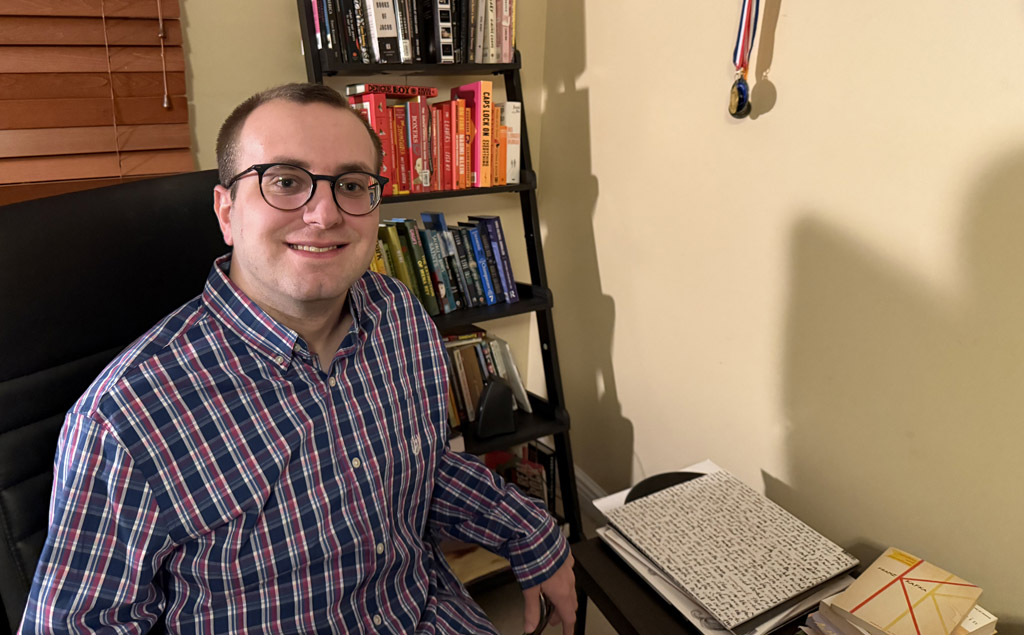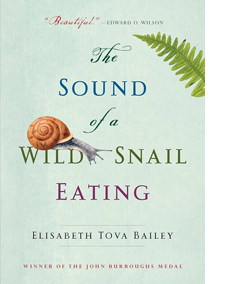
The Sound of a Wild Snail Eating
by Elizabeth Tova Bailey

Elizabeth Tova Bailey’s The Sound of a Wild Snail Eating (Algonquin Books, 2010, illustrated by Kathy Bray) comes to the gallery by way of Providence city archivist Caleb Horton and Jennifer Ziller. If its title sounds like a Zen koan, an unanswerable paradise, well, you’ll be happy to know a wild snail makes more noise eating than one hand does clapping. 2,642 tiny teeth on a baby carrot make a sound like crumpling paper.
It’s one of those questions in the world that’s much more taxing to ask, even to think about asking it, than to find the answer to. Bailey, a prominent food and gardening writer, spends a year bedridden with a complicated, chronic illness that robs her of her energy. Even on her strongest days, sitting upright for any time at all is a luxury; walking to the studio apartment’s clawfoot tub is a bygone fantasy. A friend gone out for a walk bestows her with a forest snail, given a violet pot and later a terrarium to rove around.
The snail in its miniature ecosystem sits on her nightstand as the only company within her reach. It prefers the dry, wilted leaves of her salads and stamps perfectly square bite marks into portobello mushrooms. It paves a trail of slime before it moves. It only perceives the world through touch, smell, and taste.
As Bailey watches over her snail, she assimilates its world of slowness as her own. Her accounts of the snail’s behavior are finely combed and elegantly rendered, fleshed out post-hoc by extensive scientific research and excerpts ranging from classic haikus to Rilke’s Letters to a Young Poet. Bailey tells of the snail’s anatomy, locomotion, and courtship with such a crystal-clear focus, you get the sense that all she needed was the names for them.
So The Sound will teach you what a snail’s radula is – a conveyor belt of thousands of teeth that scrapes food particles off the ground – but it’s given weight by Bailey’s ability to recognize its importance to how her tiny snail bobs its head while nibbling a mushroom. With a chronic disease like that of Bailey’s, even the tiniest, least perceptible motions demand herculean risk. Her pain brings her closer to the snail’s lack thereof.
Practically fastened to a perfectly flat bed, she’s transported in place by her illness. It’s closest to a spacecraft, an unidentified flying object she’s stuck inside. “As the snail’s world grew more familiar, my own human world became less so; my species was so large, so rushed, and so confusing,” she writes. When her friends pay a visit, she’s bewildered by each and every one of their movements around the room – “they were just so careless with it.” Their movements become nervous fidgets. How could a body be so still? Bailey registers all of it.
Convalescing brings her closer to the human world, but further from the snail’s. Where Bailey could preside over the first snail effortlessly, watching the offspring exerts a tangible amount of patience. The snail keeps her sane as the only thing she can know. While the healthcare system kept Bailey in limbo, waiting for appointments and undergoing countless tests for no clear answers, her snail had sired a whole new generation.
In the 15 years since the memoir’s publication, itself a labor refined for years after Bailey’s most severe and persistent episode of fatigue, some answers have arrived. The epilogue states her condition did most of its damage on her autonomic nervous system, likely following a tick-borne infection that “unmasked” a mutation in her mitochondria. The researchers she spoke with later deduced her mollusc companion as Neohelix albolabris, a land snail abundant in New England.
Even with its deeper mysteries illuminated, The Sound of a Wild Snail Eating resounds with a curiosity that’s genuinely vital. It’s not paced like a snail, it’s paced by the snail. Every detail is tactfully zoomed in to reveal its endless angles for exploration, imploration. And once again, it opens our minds to the noise of a snail chewing on a carrot.
